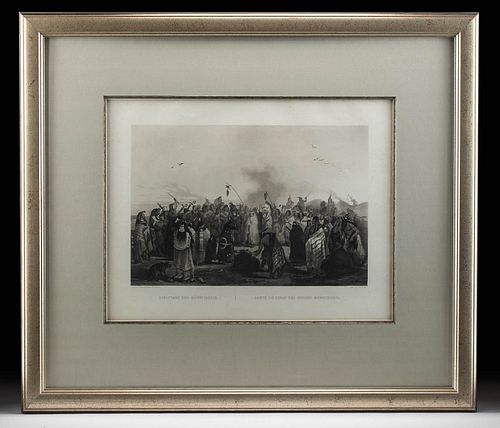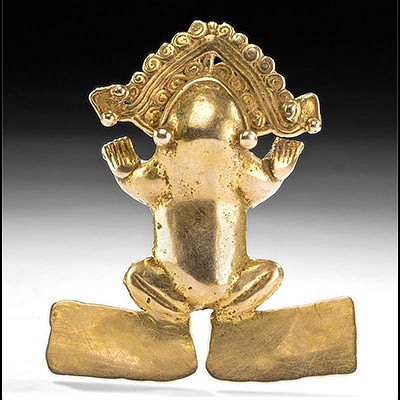Framed Bodmer Aquatint Engraving - Danse du Scalp, 1840
Lot 129a
About Seller
Artemis Fine Arts
686 S Taylor Ave, Ste 106
Louisville, CO 80027
United States
Selling antiquities, ancient and ethnographic art online since 1993, Artemis Gallery specializes in Classical Antiquities (Egyptian, Greek, Roman, Near Eastern), Asian, Pre-Columbian, African / Tribal / Oceanographic art. Our extensive inventory includes pottery, stone, metal, wood, glass and textil...Read more
Categories
Estimate:
$6,000 - $9,000
Absentee vs Live bid
Two ways to bid:
- Leave a max absentee bid and the platform will bid on your behalf up to your maximum bid during the live auction.
- Bid live during the auction and your bids will be submitted real-time to the auctioneer.
Bid Increments
| Price | Bid Increment |
|---|---|
| $0 | $25 |
| $300 | $50 |
| $1,000 | $100 |
| $2,000 | $250 |
| $5,000 | $500 |
| $10,000 | $1,000 |
| $20,000 | $2,500 |
| $50,000 | $5,000 |
| $100,000 | $10,000 |
| $200,000 | $20,000 |
About Auction
By Artemis Fine Arts
Aug 13, 2020
Set Reminder
2020-08-13 10:00:00
2020-08-13 10:00:00
America/New_York
Bidsquare
Bidsquare : Fine Antiquities, Ethnographic & Fine Art
https://www.bidsquare.com/auctions/artemis-gallery/fine-antiquities-ethnographic-fine-art-5415
Features classical antiquities, ancient and ethnographic art from cultures encompassing the globe. Egyptian, Greek, Roman, Etruscan, Near Eastern, Asian, Pre-Columbian, Native American, African / Tribal, Oceanic, Spanish Colonial, Russian, Fine Art, so much more! Artemis Fine Arts info@artemisfinearts.com
Features classical antiquities, ancient and ethnographic art from cultures encompassing the globe. Egyptian, Greek, Roman, Etruscan, Near Eastern, Asian, Pre-Columbian, Native American, African / Tribal, Oceanic, Spanish Colonial, Russian, Fine Art, so much more! Artemis Fine Arts info@artemisfinearts.com
- Lot Description
Artist: Karl Bodmer (also Johann Carl Bodmer, Swiss-French, 1809-1893); Engraver: Charles Vogel (Swiss or German). Title: "Scalptanz der Monnitarris" / "Danse Du Scalp des Indiens Meunitarris". Published: "imp. Par Saunier" (ca. 1840). An outstanding, original aquatint engraving of Karl Bodmer's "Scalptanz der Mönnitarris Danse du scalp des indiens Meunitarris" depicting a group of Hidatsa Indians engaged in a ceremonial dance. Please note that this print includes a blind stamp at the lower center that reads "C. Bodmer". It is an original aquatint engraving of a magnificent composition by Carl Bodmer, one of the most revered 19th century artists of the American West who accompanied German explorer Prince Maximilian zu Wied-Neuwied on his Missouri River expedition from 1832 through 1834. Size: 17.25" W x 11.75" H (43.8 cm x 29.8 cm); visible sheet measures 20.75" W x 16.25" H (52.7 cm x 41.3 cm); 33.625" W x 29.375" H (85.4 cm x 74.6 cm) framed
Karl Bodmer's works demonstrate his immense technical virtuosity and during his day provided a detailed image of a previously little known (and unfortunately not long for this world) way of life. Prince Maximilian zu Wied-Neuwied (1782-1867) invited Bodmer to create a visual record of his travels in North America, primarily to learn more about the Plains Indians in this era.Bodmer's visual images were particularly important as he was working prior to the invention of the camera. The pair along with David Dreidoppel, the Prince's hunting companion and servant, traveled from 1832 to 1834. They landed in Boston in July 1832, then traveled to Philadelphia, where Napoleon Bonaparte's elder brother Joseph hosted them. Next, they headed west via Pennsylvania across the Alleghenies to Pittsburgh and the Ohio country, all the while visiting important German settlements - the utopian colony of New Harmony in Indiana being a particularly important stop. It was there that the Prince spent five months in the company of some of the countries leading experts, and studied informative literature about the American frontier. On March 1833, the party reached St. Louis, Missouri, and set off on their journey to meet and learn about Native Americans.
The trio left St. Louis aboard the steamer known as Yellow Stone on April 10, 1833. Proceeding up the perilous Missouri River following the line of forts established by the American Fur Company, they first met Native Americans at Bellevue; next, they met the Sioux peoples, all the while learning everything they could and recording the little known ceremonial dances and customs. Next, they transferred from the Yellow Stone to the Assinboine steamer, and continued to Fort Clark, visiting the Mandan, Crow, and Mintari tribes, and then the Assinboins at Fort Union, which was the primary base of the American Fur Company. They next boarded a smaller vessel to travel through the geological region of that section of the Missouri to Fort Mackenzie in Montana, where they cautiously established a friendship with the legendarily fierce Blackfeet. This was their westernmost point, as it was considered much too dangerous to continue on. Hence, they returned downstream, and the winter months presented their own set of challenges. However, Bodmer continued to create magnificent studies of the peoples, dances, and villages.
Provenance: private John and Mary Williams collection, Boulder, Colorado, USA
All items legal to buy/sell under U.S. Statute covering cultural patrimony Code 2600, CHAPTER 14, and are guaranteed to be as described or your money back.
A Certificate of Authenticity will accompany all winning bids.
We ship worldwide and handle all shipping in-house for your convenience.
#151791This aquatint engraving has not been examined out of the frame but appears to be in very good condition. One can see some expected age wear - normal foxing to margins and one minute scuff to sky in upper right. The artist's blind stamp is at the lower center and reads "C. Bodmer". The work is professionally framed with museum quality materials.Condition
- Shipping Info
-
All shipping is handled in-house for your convenience. Your invoice from Artemis Gallery will include shipping calculation instructions. If in doubt, please inquire BEFORE bidding for estimated shipping costs for individual items.
-
- Buyer's Premium



 EUR
EUR CAD
CAD AUD
AUD GBP
GBP MXN
MXN HKD
HKD CNY
CNY MYR
MYR SEK
SEK SGD
SGD CHF
CHF THB
THB
















